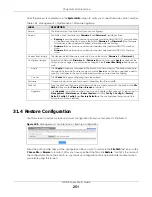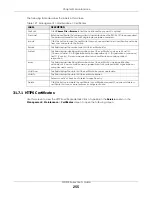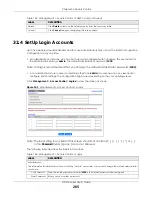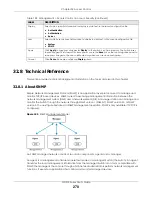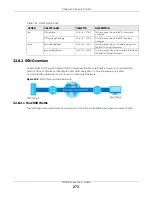
Chapter 32 Access Control
GS1915 Series User’s Guide
259
C
HAPTER
32
Access Control
32.1 Access Control Overview
This chapter describes how to control access to the Switch.
A console port and FTP are allowed one session each, Telnet and SSH share nine sessions, up to five web
sessions (five different user names and passwords) and/or limitless SNMP access control sessions are
allowed.
A console port access control session and Telnet access control session cannot coexist when multi-login
is disabled.
32.1.1 What You Can Do
• Use the
Access Control
screen (
) to display the main screen.
• Use the
SNMP
screen (
) to configure your SNMP settings.
• Use the
Trap Group
screen (
) to specify the types of SNMP traps that should
be sent to each SNMP manager.
• Use the
User Information
screen (
) to create SNMP users for authentication
with managers using SNMP v3 and associate them to SNMP groups.
• Use the
Logins
) to assign which users can access the Switch
through Web Configurator at any one time.
• Use the
Service Access Control
screen (
) to decide what services you may
use to access the Switch.
• Use the
Remote Management
) to specify a group of one or more
“trusted computers” from which an administrator may use a service to manage the Switch.
• Use the
Account Security
screen (
) to encrypt all passwords configured in
the Switch. You can also display the authentication, authorization, external authentication server
information (RADIUS), system and SNMP user account information in the configuration file saved.
32.2 Access Control Main Settings
Use this screen to display the main screen.
Click
Management
>
Access Control
in the navigation panel to display the main screen as shown.
Table 130 Access Control Overview
Console Port
SSH
Telnet
FTP
Web
SNMP
One session
Share up to 9 sessions
One session
Up to 5 accounts
No limit







